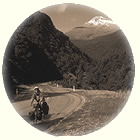
The Bacchetta Giro 26
Updated March 31 2017
home![]() The Bacchetta Giro 26 recumbent
The Bacchetta Giro 26 recumbent
 |
The Bacchetta Giro 26Updated March 31 2017 home |

The conversion point for me was reading Richard Evans's book relating his 6-month world tour on a Giro 26. He extended his love of Audax rides and the PBP to taking on the Guiness Record. I was only an hour or two into the Kindle edition of his travelogue when the pieces fell into place for me. His account chimed with with Tim Cope and Chris Hatherley's bike choice. Reading their Moscow to Beijing bike ride book and film of riding some of the worst roads in Asia got me thinking. If you haven't read either account, you should! Tim's film of the trip (made with National Geographic help) is well worth watching too. Their bikes seem to have been custom made. The Giro 26 looks to be very close to their design, although they had Rock-Shock forks. Watching the film below, it also looks like their under-saddle steerer bars made the bikes a difficult package to push - the handlebar swings up conveniently on the Giro to push from a conventional position when walking beside the bike. Also, I think their small front wheel makes their bikes a little lower to the ground - you see it's hard for Chris to get his foot down when the biike stalls crossing a river in the video, but I haven't had this problem yet.

This is our first recumbent bike, do you know whether the Ortlieb panniers for recumbents need an extra rack to be fitted to support them if using them with this bike? I have marked the attachment points that a rack could be mounted on, specifically the threaded lugs indicated by arrows on the diagram?
The first thing people comment on is how high the pedal looks from the ground, and the challenge that this must be to riding from a standing start. I've borrowed two or three other recumbents (Scorpions, primarily) before this and I actually find that the 26" wheel seems to be easier to manage than bikes with a 20" wheel, perhaps the gyroscopic effect is greater once the wheel starts turning. I have only had a day or two to ride the Giro so far but I adapted very rapidly to the riding position. The bike certainly soaks up potholes and bumps in the road well, but at low speeds I find the tiller steering needs thinking about - for example when cornering at a T-junction I have to stop pedalling and sometimes I have to lift the bars over my knees to get enough turn on the wheel. I think that with more confidence I'll steer more by banking than by turning.
The often-claimed benefit of recumbent riding is lower wind resistance, but I typically ride at only 10-15 mph, so marginal differences there. The big difference is the comfort of riding with your weight supported between your thighs and your shoulders on the seat. Currently, I find that I stop riding because my wrists and neck are sore, not because my legs are knackered. The Giro 26 completely removes that discomfort. The use of 26" wheels makes it much easier to find spare parts than if the bike had odd sizes - even 20 inch Schwalbe Marathon tires are hard to find. The as-built bike I've bought has Avid V-brakes, Campagnolo Veloce chainset, Shimano front derailleur and SRAM wide-ratio rear derailleur. The wheels don't look that heavy duty and will likely be upgraded with a SON dynamo hub to power a USB 2-amp charger. The hubs and frame are disk brake compatible but I am not a great fan of disk brakes, I think they put undue stress on the forks of a bike, especially when the bike has low rider front racks installed. The handlebars swing up and are adjustable with an allen bolt for how far they'll swing down - mine are now on the lowest setting. The seat can also be swung into a lower position but I'll need more experience before I lower it further. The actual seat clamp is very easy to adjust to move the seat forward or backwards and the frame is good for anyone up to about 6' tall. The arrangement of the chain means that you don't need to shorten it when a different sized rider adjusts the seat, which is a benefit. The rear hub sports a 9-speed cassette cluster with gear ratios from 14 to 34 teeth.
The huge 34-tooth sprocket makes life hard for the spring on the SRAM rear derailleur, since it has to soak up about four inches of chain more than it would do in a conventional set-up when changing between the inner chainring and the outer chain ring. That was just too much for it until I shortened the chain and adjusted the front derailleur screws to use the inner and middle rings only. I suspect I may have to fit something in the way of a extra chain tensioner in order to use all three chainrings without having the rear derailleur tangle itself up if I mistakenly change to the smallest rear sprocket when on the inner chainring.
Richard Evans's book is available on Amazon Kindle.
[ Home | Strictly Business | Near Misses | Cycletouring ]